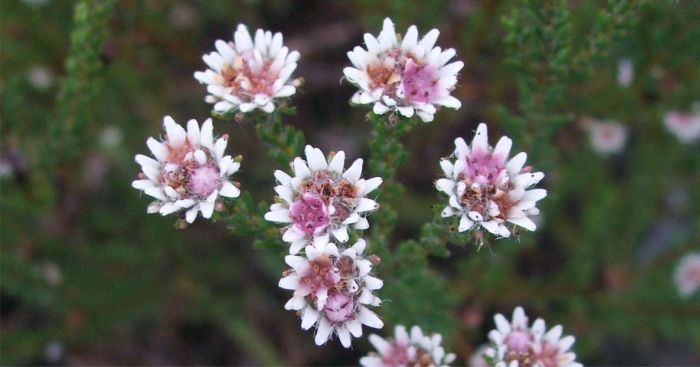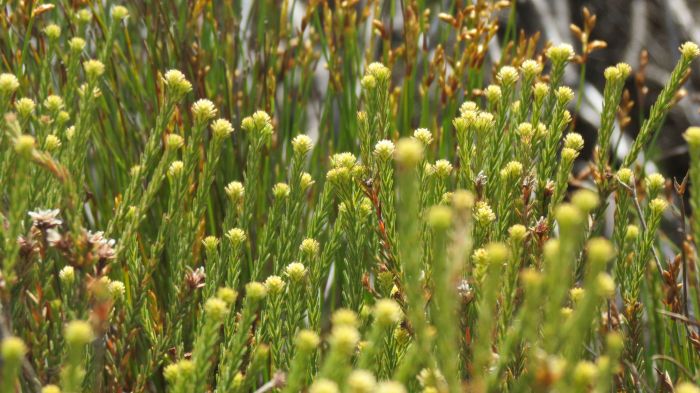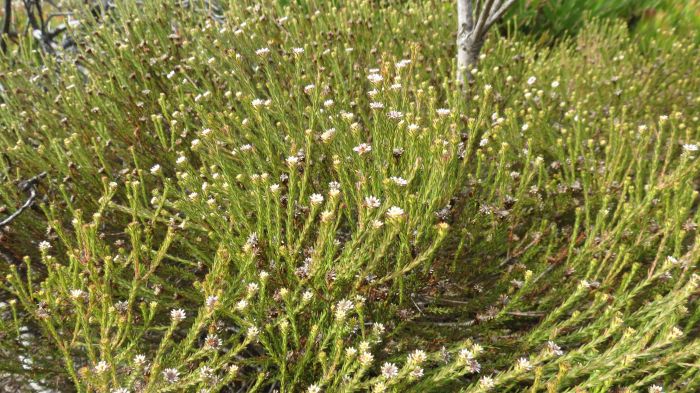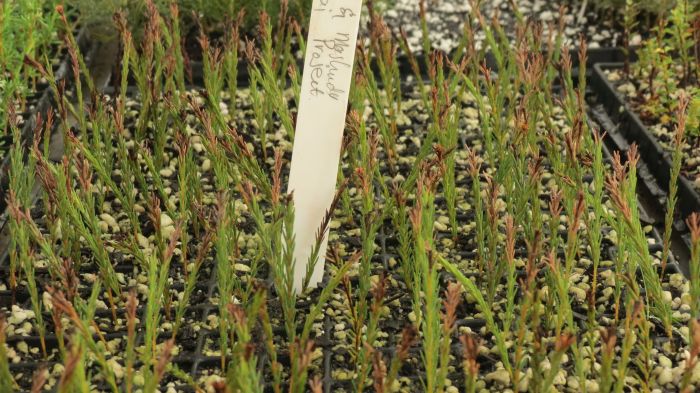Staavia radiata
Staavia radiata (L.) Dahl
Family: Bruniaceae
Common names: mini diamond eyes (Eng.); altydbos, altydbossie, glasogies (Afr.)
Introduction
A daisy-like fynbos shrub and a favourite in horticulture, with a good reputation, as it responds well to being trimmed and maintained, once propagated. This resprouter flowers in early summer, and it is also used in the cut-flower industry to make bouquets because of its appealing appearance and long-lasting nature.

Description
Description
Staavia radiata is a small shrub that grows to a height of 600–900 mm and has a woody stem which is concealed underground. The covered stem is resistant to fire, enabling the plant to resprout quickly after fire. The juvenile branches and leaves are covered in long, soft hairs (pilose). The adult branches are woody, with leaves that are green, bristly, needle-like and 4–7 mm long.

The flowers are tightly packed in small clusters, in solitary heads which are 30–50 mm across, located at the tips of the stems (terminal), with 1 or rarely 2 flowers open at the same time. The heads of small pink flowers are encircled by radiating, white, pale-yellow, or pinkish bracts of differing lengths, giving them a daisy-like appearance. The plant derives its common name, altydbos (meaning ‘always bush’), from its ever-flowering nature; its flowers appear to last forever because the floral bracts persist long after the flowers have died, making it look like it flowers all year round, whereas it flowers in spring and early summer (from September to December).

Conservation Status
Status
The species is common and not threatened, and has been given a conservation status of Least Concern (LC) by the Red List of South African plants. Although Staavia radiata resprouts strongly after a fire, it can become locally threatened if the area is burned too frequently or does not burn often enough; and again if over harvested for the cut-flower industries, without permission. Other species in the genus that are threatened, are S. doddii and S. glutinosa (Rare), S. brownii (Vulnerable), S. verticillata and S. phylicoides (Endangered) and S. zeyheri (Critically Endangered).

Distribution and habitat
Distribution description
The plant is often found in the sandy Cape Flats and on mountain slopes located near Cape Town, South Africa. The range of distribution is from Malmesbury to Riversdale in the Western Cape Province. The dominant climate is a Mediterranean climate with average temperatures in this region varying between 16.7ºC–25ºC, and the annual rainfall from 353 mm to 407 mm, with most falling during the winter months.

Derivation of name and historical aspects
History
Bruniaceae is a small family of shrubs, most restricted to and endemic to the Cape Floristic Region with a small number occurring in KwaZulu-Natal. It consists of 12 genera and 76 species. Staavia is a genus in this family; it contains 12 species and is endemic to the Western Cape. The genus was named after Martin Staaf (1731–1788), a botanist and peer to Linnaeus, in 1772. The species name radiata, is a Latin word meaning ‘to spread from the centre’ or ‘radiating’, referring to the involucral bracts that radiate around the small flowerheads, like the ray petals of a daisy.

Ecology
Ecology
This delicate shrub with daisy-like flowers has a generalist insect pollination system and attracts a variety of insect species, including honeybees and butterflies. After fire, the plants resprout from a persistent, woody rootstock.
Uses
Use
There are no known magical or medical uses associated with Staavia radiata, however, it can add value to a fynbos garden. It is also traded by flower shops and horticulturists as a cut-flower used in bouquets and as a long-lasting fynbos decoration.

Growing Staavia radiata
Grow
Propagating Staavia radiata from seed and cuttings is challenging.
Seed collection is difficult because the seeds are very small and the flowers are everlasting, thus, one does not know whether the seeds are ripe and ready, or have already been shed or are underripe and not available. But once seeds are collected, and sown in autumn, germination occurs after 2 to 3 weeks. Seeds are treated with smoke from burning fynbos before being sown; this breaks the seed dormancy and increases the percentage of seeds that germinate.
Rooting Staavia radiata cuttings from any part of the vegetative growth is difficult. Cuttings which root better are heel cuttings taken from resprouting vegetative growth after a fire. A root stimulating hormone, such as auxin powder or IBA, is used to propagate 50–70 mm long cuttings. Visible flower parts are removed, and cuttings dipped in a solution of Kelpak and watered before propagation. The cuttings are placed in a medium suitable for fynbos (a mixture of fine-milled bark and perlite). The excess powder is allowed to stay on the cutting, and where it is placed in the moist medium, by first making a thin hole with a sterile wire and then placing the cutting in the hole. The tray with cuttings is labelled and then placed in the propagation mist house.
The mist house has a temperature of 25(±2)ºC, and it also sprays water every 15 minutes for 5 seconds to keep the rooting medium moist, leaves cool and moist, while the beds are heated and kept at a warm temperature of 22–25ºC. The cuttings root after 2–3 months, are hardened off for a week in a shady area and then potted into 2 kg nursery bags, using a fynbos soil mix. They are watered regularly and given organic fertilizers once a month for increased growth, and planted into the garden when ready.
Staavia radiata needs a sunny position with free air circulation, in sandy, acidic soil. It is ideal for fynbos gardens. Plants are long-lived and resprout after being cut back.
References
- Foden, W. & Potter, L. 2005. Staavia radiata (L.) Dahl. National Assessment: Red List of South African plants version 2020.1. Accessed on 2021/04/18.
- Harvey, W.H. 1811–1866. Flora capensis: being a systematic description of the plants of the Cape Colony, Caffraria, & Port Natal (and neighbouring territories) Volume 2.
- Pillans, N.S. 1947. A revision of Bruniaceae. Journal of South African Botany. 13: 170–172.
- Powrie, F. 1992. Growing staavias – new rare plants in cultivation. Botanic Gardens Conservation News 2: 51–55.
- Powrie, F. 1994. Staavias in cultivation. Veld & Flora 80: 24–26.
Credits
Siqamo Yeko
Kirstenbosch National Botanical Garden (CBC)
May 2021
Acknowledgements: thanks to Mr Erica (Kamogelo Solomon Modimola) for his insights on cultivation and for providing the images of Staavia radiata from his observations on iNaturalist.
Plant Attributes:
Plant Type: Shrub
SA Distribution: Western Cape
Soil type: Sandy
Flowering season: Spring, Early Summer
PH: Acid
Flower colour: White, Pink, Cream, Yellow
Aspect: Full Sun
Gardening skill: Challenging
Special Features:
Horticultural zones







Rate this article
Article well written and informative
Rate this plant
Is this an interesting plant?
Login to add your Comment
Back to topNot registered yet? Click here to register.